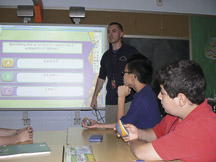Anyone who still has trouble hooking up a television set, DVD player, and cable TV wires would be hard pressed to pass the sixth grade these days. Or fourth grade, for that matter. In fact, soon even the Underoos crowd will be more tech-savvy than folks who haven’t even mastered the art of typing with their thumbs.
“If I could put curriculum into an X Box or a game system I would.” – Sean Powers
________
“If I could put curriculum into an Xbox or a game system, I would,” said sixth grade Huber teacher Sean Powers, while demonstrating the Promethean Board, the latest teaching technology to hit the classroom in the Secaucus school district. “The students are much more eager to learn and participate in the lesson plan when I use Promethean. They’re active learners, rather than passive learners.”
Promethean is one of two types of so-called “smart boards” currently being introduced to classrooms at Huber. Promethean is an interactive white board that allows teachers to program lesson plans with a student participation component.
Powers’ class, for example, was recently learning about probability. He was able to program such multiple choice questions as “Something that is likely to happen has a probability of between…” into Promethean and have the questions appear on the board. Students were then assigned remote control devices and could register their answers by typing the letters A, B, or C.
“Right away, I can see what percentage of the class got the right answer, and what percentage got the wrong answer,” Powers explained. “If every student answers the question correctly, that lets me know I can move on to the next question. But if there were students who answered incorrectly, that immediately lets me know I need to explain the information to them again.”
Before such tools were available, he added, a teacher wouldn’t have known whether students had absorbed the information until after giving a quiz or a test.
Promethean also allows teachers to program photos, graphics, or brief film clips and videos into a lesson plan, and the board can be used for any subject matter – math, social studies, history, etc.
“This technology doesn’t in any way replace the teacher, or any of the traditional learning tools that educators have used in the past,” said Huber Principal Fred Ponti. “This is a teaching tool that simply enhances lesson plans, discussion, and textbooks.”
Huber currently has three Promethean boards, which were installed in February. To use the system, teachers have to get special training, and have the opportunity to get ongoing tutorials offered by Promethean’s developers.
Study Island
While Promethean is the latest gadget to hit the classrooms, it isn’t the only interactive tool teachers are using at Huber. Computer science teacher Lucille Wright uses internet-based Study Island to teach students in grades two through six. Study Island allows students to call up test questions and worksheets and practice reading and math skills while working individually at their own pace.
“One unique feature of Study Island is that when you give a test, neighbors won’t have the same questions on their computer screens, so it prevents cheating since looking at your neighbor’s screen won’t do you any good,” she said.
As with Promethean, Study Island generates multiple choice questions and answers and gives students the option to do additional work on their own at home.
“Each student has a login and password,” Wright said. “So, in their free time at home they can log on to Study Island, type in their assigned login and password and work on things they need help with.”
In class, Wright said she restricts students to “test mode” and “printable worksheet” mode, but at home they have access to educational computer games through Study Island as well.
Technology and assessments
Ponti said the new technology being implemented at Huber has helped educators in another way: rating student performance for state mandated assessment tests.
“Whether we like it or not, these assessment tests are going to be with us for a long time to come,” Ponti said. “So the best thing for educators to do at this point is help our students do well on them.”
Because student performance can be broken down to minute detail, teachers are able to test students at school and give parents a printout of exactly what type of information their children understand, and where they still need help. These tests, Children’s Progress and Progress Toward Standards 3, can assess, for example, whether a student has difficulty in reading comprehension or fractions, and they can let parents know how their children score based on state assessment standards.
“Teachers have always been hard workers,” Ponti said. “These tools now allow them to work hard, but also to work smarter.”
E-mail E. Assata Wright at awright@hudsonreporter.com.
